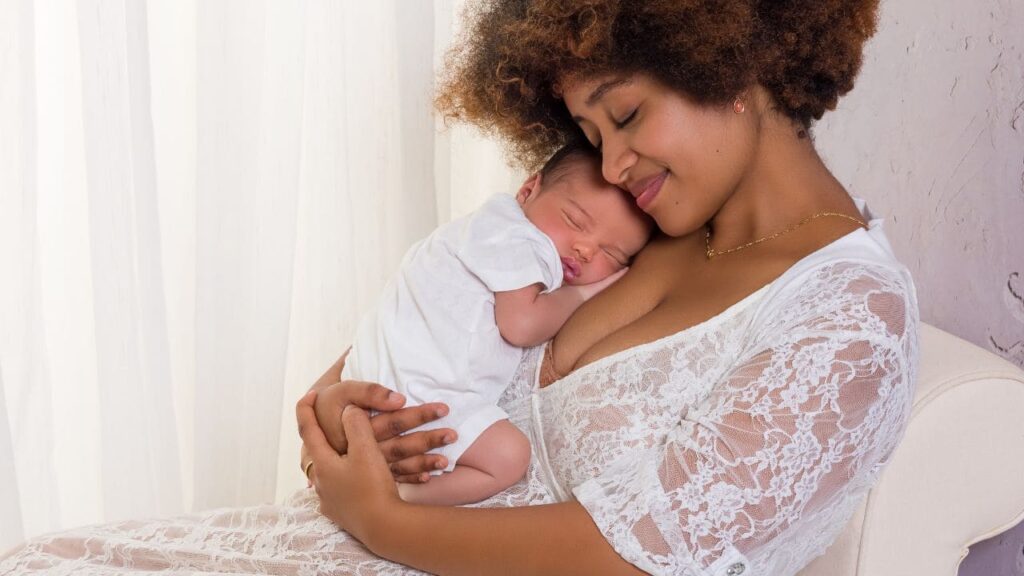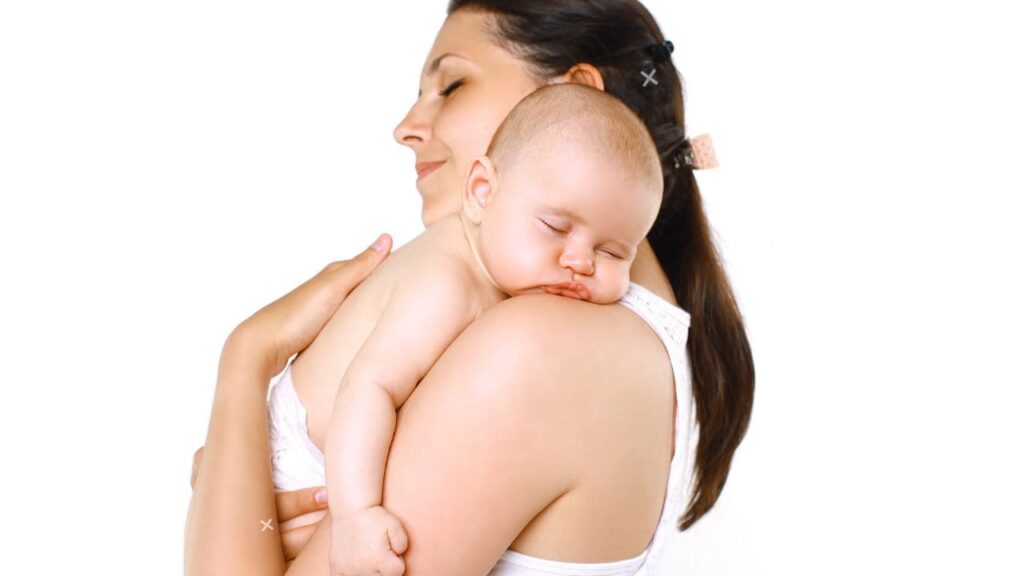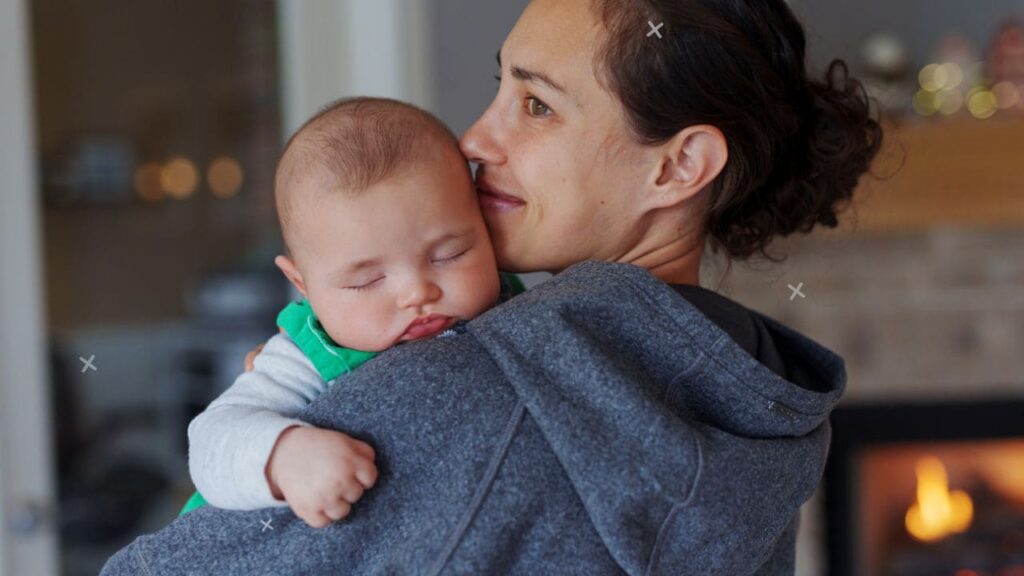Ah, the joys and challenges of having a newborn! If you’re like many parents, you may have found that your little one only seems content to drift off to dreamland when snuggled up in your arms. While it’s a beautiful bonding experience, it can also be exhausting and make it tough to get anything done during those precious naptime hours.
Rest assured, you’re not alone in this struggle. Many newborns have a strong preference for being held while they sleep, and there are some very good reasons behind this. In this comprehensive guide, we’ll explore why your baby may only want to sleep when held, as well as 9 innovative methods you can try to help soothe and settle them so they can get the restorative rest they need – and you can too!

Understand Why Newborns Often Only Sleep When Held
Newborns have just embarked on the incredible journey of transitioning from the cozy confines of the womb to the wide, wonderful world. It’s no wonder they often find the most comfort and security in the familiar embrace of their parents’ arms.
You see, during pregnancy, your little one was surrounded by the gentle rocking motions, muffled sounds, and snug sensations of being inside you. This constant physical closeness and support triggered the release of hormones like oxytocin that promoted feelings of calm and relaxation. Now on the outside, your baby is suddenly exposed to all new sights, sounds, and sensations that can feel overstimulating and unsettling.
Holding your newborn close replicates many of those womb-like experiences, providing a sense of safety and soothing that allows them to drift off to sleep more easily. Infant sleep researcher Dr. Nilong Vyas explains, “Newborns are hardwired to want that physical closeness and contact. It triggers their calming reflex and helps them transition from the womb to the outside world.”
Additionally, some babies may develop a habit of only falling asleep while being held due to learned associations. As new parents, it’s very natural to want to comfort a crying or restless infant by immediately picking them up and rocking them to sleep. Over time, this can reinforce the expectation that falling asleep requires parental support.
Of course, there may also be other factors at play, like reflux, colic, or simply an innate temperament that leans more towards needing physical soothing. Regardless of the reason, with patience and the right techniques, you can help your little one learn to drift off to sleep on their own.
The Challenges of the Fourth Trimester
The newborn stage is often referred to as the “fourth trimester” because it’s a critical period of adjustment and development for your baby. During this time, they’re still adapting to life outside the womb and may have a heightened need for the familiar sensations they experienced in utero.
This can make the transition to independent sleep particularly challenging. Newborns have an immature nervous system, which means they rely heavily on external cues and regulation to soothe themselves. Things like the constant rocking, white noise, and snug containment of the womb are suddenly gone, leaving them feeling disoriented and unsettled.
Parenting expert Laura Howells explains, “Newborns are essentially still ‘inside’ when they’re born. Their sensory systems are still developing, so they feel most secure and relaxed when they can recreate that womb-like environment.” This is why holding and physical touch are so crucial during this transitional period.
The Importance of Bonding and Attachment
While helping your newborn learn to sleep independently is important, it’s equally vital to nurture the bond and attachment between you. Those precious moments of skin-to-skin contact, rocking, and cuddling are not only soothing for your baby, but they also play a critical role in their emotional and social development.
Numerous studies have shown that responsive, attuned caregiving during the newborn stage lays the foundation for secure attachment. This, in turn, supports healthy brain development, self-regulation, and social-emotional skills as your child grows.
So, while you may need to gently encourage your little one to sleep on their own, don’t hesitate to savor those cozy cuddles too. Newborn sleep expert Alanna McGinn advises, “Enjoy this special time of bonding. Your baby won’t be little forever, so soak up those snuggles whenever you can.”

Tips for Soothing a Newborn Who Won’t Sleep in the Bassinet
Now that we’ve explored some of the reasons behind your newborn’s preference for sleeping while being held, let’s dive into 9 innovative methods you can try to help them adjust to sleeping independently in their bassinet or crib.
- Create a Calming Sleep Environment Setting the stage for quality rest is key. Start by ensuring the nursery is dark, quiet, and a comfortable temperature (ideally between 68-72°F). Use blackout curtains or an eye mask to block out any stimulating light, and consider adding a white noise machine or fan to mask disruptive sounds.
You can also try incorporating calming, pleasant smells like lavender or chamomile essential oils. Just be sure to keep them well out of your baby’s reach. Maintaining a tranquil, womb-like atmosphere can go a long way in helping your little one feel secure and ready to drift off.
- Try Different Swaddling Techniques Swaddling is an age-old practice that can work wonders for soothing newborns. The snug, cozy feeling of being wrapped mimics the comfort of the womb and can help prevent the startle reflex that often wakes babies.
However, it’s important to learn proper swaddling techniques to ensure your baby’s safety. Avoid wrapping too tightly or keeping them swaddled once they show signs of trying to roll over. Start with their arms wrapped close to their body, then gradually transition to having their arms free as they get older.
- Incorporate Gentle Rocking or Swaying The gentle, rhythmic motions of rocking, swaying, or even using a baby swing can have a profoundly calming effect on newborns. It replicates the natural rocking they experienced in the womb and triggers the release of those soothing hormones.
Try holding your baby close while gently swaying side to side, or sit in a rocking chair and let the motion lull them to sleep. You can also invest in a baby swing or vibrating bassinet to provide that comforting sensation even when you need to step away.
- Use Calming White Noise Recreating the familiar, comforting sounds of the womb can go a long way in helping your newborn fall and stay asleep. White noise machines, fans, air purifiers, or even an app that plays soothing sounds can help mask startling noises that might otherwise rouse your little one.
The constant, gentle hum of white noise mimics the whooshing sounds your baby heard in utero, triggering their natural relaxation response. It’s like a musical lullaby that helps drown out household sounds and signals to your newborn that it’s time to drift off.
- Gradually Transition to the Bassinet If your newborn has become accustomed to only sleeping while being held, the transition to their own sleeping space can understandably be challenging. Instead of going straight from snuggling to the bassinet, try taking a more gradual approach.
Start by having your baby nap in the bassinet for short periods during the day, then slowly increase the duration over time. You can also try placing the bassinet right next to your bed so they can still feel your presence, then gradually move it further away as they get used to it. Consistency and patience are key during this transition.
- Encourage Self-Soothing with Pacifiers Offering a pacifier can be a game-changer when it comes to helping your newborn learn to self-soothe and fall asleep independently. Sucking is an innate, calming reflex for babies, and a pacifier can provide that comforting sensation even when you’re not there to hold them.
Just be sure to introduce the pacifier properly and avoid letting your little one become too reliant on it for sleep. Aim to use it as a tool to help them transition into deeper, more restorative sleep on their own, not as a constant crutch.
- Establish a Calming Bedtime Routine Implementing a consistent pre-bed routine is crucial for signaling to your newborn that it’s time to wind down and get some shut-eye. This might include activities like a warm bath, gentle massage, nursing or bottle-feeding, and reading a soothing story.
The key is to keep this routine predictable and calming. Avoid overstimulating activities right before bed, and try to stick to the same sequence each night. Over time, your baby will associate these familiar steps with the onset of sleepiness, making it easier for them to drift off – even without being held.
- Experiment with Different Sleeping Positions While the classic cradled hold is often a newborn’s favorite, there are other positions you can try that may help them feel more secure and comfortable in their bassinet or crib. Side-lying or stomach-to-stomach holds can provide a similar sense of containment and closeness.
Just be sure to follow safe sleep guidelines, keeping your baby on their back, with no loose bedding or soft objects that could pose a suffocation risk. It may take some trial and error, but finding the right sleeping position can make a big difference.
- Ask for Help from Family or a Sleep Consultant Remember, you don’t have to navigate this journey alone! Enlisting the support of trusted friends or family members can provide much-needed respite, allowing you to catch up on rest while someone else holds or soothes your little one.
You can also consider working with a sleep consultant or pediatrician who specializes in newborn sleep. They can offer personalized guidance and troubleshoot any underlying issues that may be contributing to your baby’s sleep challenges. Don’t be afraid to reach out for the help you need – it truly takes a village!
| Technique | How it Helps |
|---|---|
| White Noise | Mimics the sounds of the womb, blocking out startling noises |
| Swaddling | Provides a womb-like feeling of security and comfort |
| Rocking/Swaying | Replicates the gentle movements your baby experienced in utero |
| Pacifier | Encourages self-soothing by triggering the sucking reflex |
| Calming Bedtime Routine | Signals to your baby that it’s time to wind down and sleep |
| Gradual Bassinet Transition | Helps your baby gradually adjust to sleeping in their own space |
| Different Sleeping Positions | Allows your baby to feel more secure and comfortable |
| Enlisting Help | Provides you with much-needed rest and support |
The Potential Risks of Letting Baby Sleep Only When Held
It’s understandable to want to do whatever it takes to help your newborn sleep, even if that means holding them constantly. However, there are some potential risks to consider with this approach:
- Increased Parental Fatigue: Constantly holding a sleeping baby can be exhausting, both physically and mentally. This can lead to burnout, irritability, and difficulty caring for your little one’s other needs.
- Difficulty Transitioning to the Crib: Babies who only sleep when held may have a harder time adjusting to sleeping independently in a bassinet or crib. This can make naptime and bedtime a constant struggle.
- Unsafe Sleep Habits: Falling asleep while holding your baby increases the risk of SIDS (Sudden Infant Death Syndrome) and other sleep-related accidents. Babies should always be placed on their backs to sleep, in a safe, flat sleeping space.
- Feeding and Scheduling Challenges: Constantly holding a sleeping baby can make it challenging to establish a consistent feeding schedule and routine, which are important for your little one’s development.
While it’s essential to meet your newborn’s needs for physical closeness and comfort, it’s equally crucial to help them learn to self-soothe and sleep safely on their own. With patience and the right strategies, you can strike a healthy balance.

Recognizing the Signs of Readiness for Independent Sleep
As your newborn grows and develops, you’ll start to notice signs that they’re becoming more ready to sleep independently. These can include:
- Longer Stretches of Awake Time: Newborns typically need to eat and sleep in shorter cycles, but as they mature, you’ll notice longer periods of wakefulness between naps.
- Self-Soothing Behaviors: Things like sucking on fingers or a pacifier, startling less, and being able to calm themselves down are all signs of emerging self-soothing skills.
- Established Circadian Rhythms: Over time, your baby’s sleep-wake cycles will become more predictable, with longer stretches of nighttime sleep.
- Reduced Need for Motion: As your little one grows, they may be able to fall asleep more easily without constant rocking or swaying.
Pediatrician Dr. Nilong Vyas recommends aiming for independent sleep around the 4-6 month mark, but every baby is different. The key is to watch for these developmental cues and use a gentle, gradual approach to help your newborn transition.
| Sign | Explanation |
|---|---|
| Longer Awake Periods | Newborns typically need to eat and sleep in shorter cycles, but as they mature, you’ll notice longer periods of wakefulness between naps. |
| Self-Soothing Behaviors | Things like sucking on fingers or a pacifier, startling less, and being able to calm themselves down are all signs of emerging self-soothing skills. |
| Established Circadian Rhythms | Over time, your baby’s sleep-wake cycles will become more predictable, with longer stretches of nighttime sleep. |
| Reduced Need for Motion | As your little one grows, they may be able to fall asleep more easily without constant rocking or swaying. |
Creating a Conducive Sleep Environment
Ensuring your newborn has a comfortable, soothing sleep environment is crucial for helping them drift off to dreamland, whether in your arms or in their own space. Here are some tips to create the perfect sleep sanctuary:
Temperature and Lighting: Keep the nursery cool, between 68-72°F, and use blackout curtains or a sleep mask to block out any disruptive light. Dim lighting signals to your baby’s brain that it’s time to wind down.
White Noise: As mentioned earlier, the consistent hum of white noise can have a incredibly calming effect, mimicking the sounds your baby heard in the womb. Consider a high-quality sound machine or app to provide soothing background noise.
Comfortable Bedding: Make sure the crib, bassinet, or co-sleeper is outfitted with a firm, flat mattress and breathable, snug-fitting sheets. Avoid any loose bedding or soft objects that could pose a suffocation risk.
Calming Scents: Essential oils like lavender or chamomile can have a relaxing effect, but always keep them well out of your baby’s reach. You can also try using a diffuser or adding a few drops to a humidifier.
By creating a sleep-promoting environment, you’ll be setting your newborn up for the best possible chance at drifting off to sleep – whether in your arms or on their own.
When to Seek Professional Support
While many newborns go through phases of only wanting to sleep while being held, there are certain situations where you may want to consult a pediatrician or sleep specialist for additional support:
Persistent Feeding or Digestive Issues: If your baby seems to be in constant discomfort due to reflux, colic, or other digestive problems, these underlying issues could be contributing to their sleep struggles. A pediatrician can help identify and address any medical concerns.
Significant Weight Loss or Lack of Growth: Newborns should be gaining weight steadily. If your little one is not meeting growth milestones or seems lethargic, it’s important to rule out any health problems that could be impacting their sleep and feeding.
Caregiver Mental Health Concerns: Dealing with a newborn who won’t sleep without being held can be incredibly draining, both physically and emotionally. If you’re feeling overwhelmed, anxious, or depressed, reach out to your healthcare provider. They can connect you with resources and support.
Developmental Red Flags: While every baby develops at their own pace, there are certain milestones you’ll want to keep an eye on, such as your newborn’s ability to self-soothe, respond to stimuli, and regulate their sleep-wake cycles. Consult your pediatrician if you have any concerns.
Remember, you don’t have to navigate these challenges alone. Seeking professional guidance can provide valuable insights and help you develop a personalized plan to support both your newborn’s sleep needs and your own well-being.
| Reason to Seek Help | Explanation |
|---|---|
| Persistent Feeding/Digestive Issues | If your baby seems to be in constant discomfort due to reflux, colic, or other digestive problems, these underlying issues could be contributing to their sleep struggles. |
| Significant Weight Loss or Lack of Growth | Newborns should be gaining weight steadily. If your little one is not meeting growth milestones or seems lethargic, it’s important to rule out any health problems. |
| Caregiver Mental Health Concerns | Dealing with a newborn who won’t sleep without being held can be incredibly draining, both physically and emotionally. Reach out if you’re feeling overwhelmed. |
| Developmental Red Flags | While every baby develops at their own pace, there are certain milestones you’ll want to keep an eye on, such as your newborn’s ability to self-soothe and regulate their sleep-wake cycles. |
Conclusion
Navigating the sleep needs of a newborn can certainly be challenging, but with patience, consistency, and the right strategies, you can absolutely help your little one transition to sleeping independently. Remember, every baby is different, so don’t be afraid to experiment to find what works best for your family.
By creating a calming environment, utilizing soothing techniques like swaddling and white noise, and slowly introducing independent sleep, you’ll be setting your newborn up for healthy sleep habits that benefit you both. And don’t forget to reach out for support when you need it – you’ve got this, Mama (and Papa)!
FAQ – Newborn Only Sleeps When Held
Why does my newborn only want to sleep when being held?
There are a few key reasons why some newborns prefer to only sleep when being held. During pregnancy, babies experience the constant rocking, soothing sounds, and snug feeling of the womb. When they’re born, this familiar environment is suddenly gone, leaving them feeling unsettled and craving that physical closeness and comfort that they’re accustomed to. Additionally, some newborns develop a habit of only falling asleep while being held, as parents naturally tend to pick them up and rock them to sleep when they’re fussy or crying. This can reinforce the expectation that parental physical support is required for sleep.
Is it safe to let my newborn sleep while being held?
While holding your sleeping newborn can be a beautiful bonding experience, it’s important to be cautious about safety. Falling asleep while holding your baby increases the risk of SIDS (Sudden Infant Death Syndrome) and other sleep-related accidents. Babies should always be placed on their backs to sleep, in a flat, safe sleeping space like a crib or bassinet, with no loose bedding or soft objects that could pose a suffocation hazard. If you do choose to hold your sleeping newborn, be sure to stay awake and alert, and transition them to a safe sleep space as soon as possible.
How do I get my newborn to sleep independently in the bassinet?
The key is to take a gradual, gentle approach to transitioning your newborn to independent sleep. Start by having them nap in the bassinet during the day, slowly increasing the duration over time. You can also try incorporating soothing techniques like white noise, swaddling, and a calming bedtime routine to help signal to your baby that it’s time to sleep.
Experiment with different sleep positions, like side-lying or stomach-to-stomach, to see what makes them feel most secure. Remember to be patient and consistent – it may take time, but your newborn will eventually learn to fall asleep on their own.
When should I be concerned about my newborn’s sleep habits?
In most cases, a newborn’s preference for sleeping while being held is a normal part of their development and adjustment to life outside the womb. However, there are a few situations where you may want to consult your pediatrician:
- If your baby seems inconsolable or is showing signs of reflux, colic, or other medical issues that could be impacting their sleep
- If your little one is not gaining weight or reaching developmental milestones as expected
- If you’re feeling overwhelmed, exhausted, or concerned about the impact on your own mental health
Your pediatrician can provide valuable guidance, rule out any underlying problems, and help you develop a plan to address your newborn’s sleep challenges.
How can I tell if my newborn is ready for more independent sleep?
There are a few key signs that your newborn may be ready to start transitioning to more independent sleep:
- Longer stretches of awake time between naps, indicating more mature sleep-wake cycles
- Emerging self-soothing behaviors like finger or pacifier sucking
- More predictable circadian rhythms, with longer periods of nighttime sleep
- Reduced need for constant motion or rocking to fall asleep
Pay close attention to your baby’s cues and developmental milestones. Around the 4-6 month mark, many newborns start showing readiness for more independent sleep. With patience and the right strategies, you can help your little one make a smooth transition.












